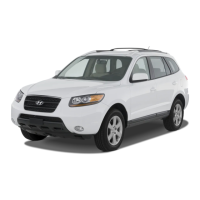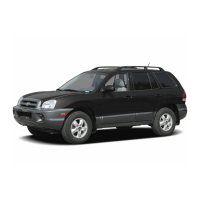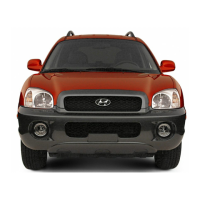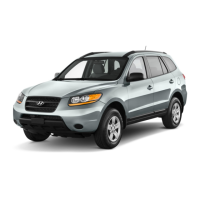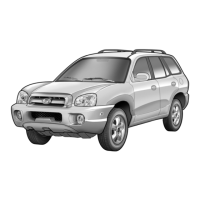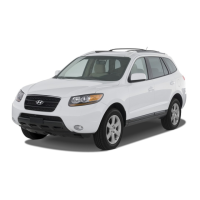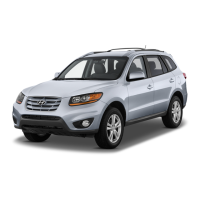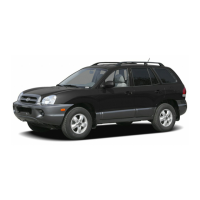Do you have a question about the Hyundai Santa Fe CM and is the answer not in the manual?
Explains the manual's layout, sections, and how to find information efficiently.
Details recommended fuel types, octane ratings, and additives for optimal vehicle performance.
Advises on safe vehicle operation, particularly concerning cornering and rollover risks.
Lists and explains various warning and indicator lights found on the instrument cluster.
Provides a diagram and list of interior controls and features with their respective page numbers.
Details the layout and components of the instrument panel, including controls and indicators.
Illustrates and labels key components located in the engine bay for easy identification.
Covers adjustments for front, 2nd, and 3rd-row seats, including manual and power seat operations.
Explains proper seat belt usage, restraint system, and precautions for maximum safety.
Provides guidelines for installing and using child safety seats, emphasizing rear seat placement.
Details the function, components, and safety precautions related to the vehicle's airbag system.
Covers key identification, operations, and security systems like the immobilizer.
Explains the operation of the remote keyless entry system, including lock, unlock, and alarm functions.
Details the functions and operation of the smart key system for keyless entry and engine start.
Explains how to operate door locks from both inside and outside the vehicle, including central locking.
Covers the operation of opening and closing the tailgate, including warnings and cautions.
Details the operation of power windows, including auto up/down and window lock functions.
Covers power steering operation, tilt steering adjustment, and horn usage.
Explains the adjustment and features of inside and outside rearview mirrors, including auto-dimming.
Provides an overview of the instrument cluster layout, including gauges and indicators.
Outlines essential pre-drive checks, necessary inspections, and safety precautions.
Explains the different ignition switch positions (LOCK, ACC, ON, START) and their functions.
Provides instructions for starting gasoline and diesel engines, including cold weather precautions.
Details the operation of the manual transaxle, including gear shifting and downshifting precautions.
Covers automatic transaxle operation, shift lever positions, and safety precautions.
Explains 4WD systems, driving practices for different conditions, and rollover risk.
Covers power brake operation, brake failure procedures, parking brake usage, and ABS/ESP systems.
Explains how to set, increase, decrease, and cancel cruise control speed.
Details the operation and limitations of the Active ECO system for improving fuel efficiency.
Offers driving tips to improve fuel economy and reduce maintenance costs.
Provides guidance for driving in hazardous conditions like snow, ice, mud, and rain.
Offers advice for winter driving, including snow tires, tire chains, and lock maintenance.
Covers essential information for towing a trailer, including hitches, safety chains, and weight limits.
Explains the function and use of the hazard warning flasher for emergency situations.
Provides step-by-step instructions for safely handling a flat tire situation on the road.
Details the procedures and safety precautions for jump-starting a vehicle with a dead battery.
Outlines steps to take if the engine overheats, including checking coolant and drive belts.
Explains the TPMS warning lights, malfunction indicators, and proper tire maintenance.
Guides on replacing a tire, addressing TPMS sensor issues after replacement.
Provides guidelines for vehicle towing, including proper procedures for 2WD, 4WD, and emergency towing.
Illustrates and labels the engine compartment components for gasoline and diesel engines.
Provides schedules for normal and severe usage conditions for gasoline and diesel engines.
Details how to check and change the engine oil and filter, including warnings and cautions.
Explains how to check, add, and change engine coolant, including safety precautions.
Covers checking and adding brake fluid, including warnings about handling and contamination.
Provides guidance on battery service, recharging procedures, and safety warnings.
Explains fuse types, panel locations, replacement procedures, and warnings about improper replacements.
Covers inspection, replacement, and care of windshield and rear window wiper blades.
Offers advice on exterior and interior cleaning, washing, waxing, and corrosion protection.
Lists the exterior dimensions of the vehicle, including length, width, height, and wheelbase.
Details the wattage specifications for various exterior and interior light bulbs used in the vehicle.
Provides information on tire sizes, inflation pressures, wheel lug nut torque, and tire rotation.
Lists recommended lubricants and fluids for the engine, transmission, and other systems.
Offers guidance on selecting the correct engine oil viscosity based on ambient temperature.
Explains where to find the VIN on the vehicle and its importance for identification.
Details how to read the tire specification label and recommended tire pressures.
| Brand | Hyundai |
|---|---|
| Model | Santa Fe CM |
| Category | Automobile |
| Language | English |


